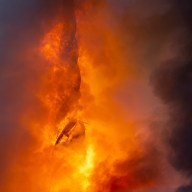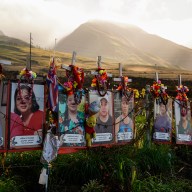julia dimon/for metro toronto
Greenland promises beautiful views of raw, untouched nature.
Brightly painted A-frame houses dot the snowy white landscape. Front yards are zip-lined with frozen laundry, skinned animal pelts and chained sled dogs, howling almost as loud as the wind.
This is Sisimiut, a fishing community on the western coast of Greenland. The world’s largest island, Greenland is three times the size of Texas, with a population of some 56,000 people, most living in the capital of Nuuk.
Greenland is raw, unapologetic nature, with endangered whales and sky-scraper-sized glaciers. Over 80 per cent of the country is ice, an environment that finds itself at the forefront of climate change.
julia dimon/for metro toronto
Brightly painted A-frame houses, with sled dogs in the front yard, found in a small settlement on the western coast of Greenland.
Depending on the season, local operators offer tourists a ton of activities: angling, trekking, dog sledding and iceberg cruises to the largest active glacier in the Northern Hemisphere.
On my very first trip to the Article Circle, I learned that Sisimiut isn’t about igloos and Eskimos. The second largest city in Greenland, it’s a mix of Inuit tradition, Danish influence and modernization. Locals wear North Face ski jackets, brand name winter boots and seal fur gloves. With cell phones and flat screen televisions, local life is far more European than I expected — but it still feels authentic.
julia dimon/for metro toronto
A local Greenlandic fisherman keeps warm.
A small fishing boat cruises into port. Men dressed in fluorescent orange jump suits return home after an early morning hunt. A bleeding seal is slung proudly over the boat’s stern. The animal-rights activist in me is horrified(a feeling I wrestle with throughout my trip) but I try to remember that in the Arctic, hunting isn’t for sport, it’s for survival.
Smoked salmon, reindeer, musk ox and whale are the usual eats. Most are delicious, all except the whale blubber. I learn first-hand that whale blubber isn’t mainstream for a reason. This white jiggly meat is tasteless, fatty and as hard to chew as a rubber tire.
Animal products, like seal furs and carved whale bones, are also sold as souvenirs. U.S. and Canadian customs forbids bringing marine mammal products (made from whales, walruses or any other creature living in the ocean) into the country. In addition to being ethically questionable, such souvenirs are also pretty expensive.
Greenland in general isn’t cheap. Most goods are imported and since there are no roads between towns, so you must fly within the country. It’s a tough destination to do solo and, while packaged tours are the most comfortable option, they ain’t cheap. If budget isn’t tight and you’re looking for an off-the-beaten-path outdoor adventure (not to mention major bragging rights), Greenland is the way to go.
Julia Dimon is a Toronto-based writer and editor of The Travel Junkie, an on-line magazine for young and restless travellers. She can be reached at www.thetraveljunkie.ca.
| julia’s tips |
|
















